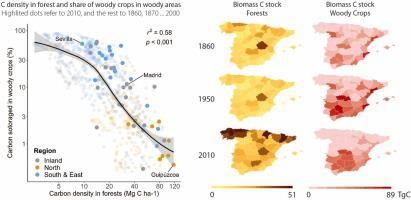Anthropocene ( IF 3.6 ) Pub Date : 2023-10-26 , DOI: 10.1016/j.ancene.2023.100416 Juan Infante-Amate , Iñaki Iriarte-Goñi , Eduardo Aguilera

|
Land-use change was the main source of anthropogenic CO2 emissions until the mid-twentieth century, especially due to deforestation processes. In recent decades, however, CO2 sequestration is being induced in some countries where forest area is experiencing net increases. Despite the key role of these processes, we hardly dispose of any empirical evidence of historical changes in biomass stocks, especially in the long-term (over 50 years) and in cultivated areas. In this study, we quantify the evolution of the surface area, carbon stocks (C) and C density of living biomass in Spain (50 provinces) between 1860 and 2010. According to our results, the C stock fell from 340.3 Tg C to 254.2 Tg C between 1860 and 1950, to then reach 844.0 Tg C in 2010. Although the stock began to increase much later than in other European countries, annual growth rates were much more significant. A decomposition analysis allowed us to observe that the increase in stock was mainly due to the change in C density (61.2% of the effect), surface area (35.3%) and, to a lesser extent, to the effect of location in more productive areas (5.7%). Woody crops – which were historically managed as agroforestry systems when combined with other crops – stored 15.8% of total stocks during the period studied. They play a particularly important role in areas with a Mediterranean climate because in these provinces, crops such as olive groves, vineyards or oranges have proliferated. The reasons for C stock increases are: the substitution of firewood with fossil fuels; agricultural intensification; and the outsourcing of land use to other countries through agricultural imports.
中文翻译:

地中海生物量碳储量的历史变化(西班牙,1860-2010)
直到二十世纪中叶,土地利用变化一直是人为CO 2排放的主要来源,特别是由于森林砍伐过程。然而,近几十年来,一些森林面积净增加的国家正在引发CO 2封存。尽管这些过程发挥着关键作用,但我们几乎没有处理任何生物量库历史变化的经验证据,特别是在长期(超过 50 年)和耕地中。在这项研究中,我们量化了 1860 年至 2010 年间西班牙(50 个省)生物量的表面积、碳储量 (C) 和碳密度的演变。根据我们的结果,碳储量从 340.3 Tg C 下降到 254.2 1860年至1950年间Tg C,2010年达到844.0 Tg C。尽管库存开始增加的时间比其他欧洲国家晚得多,但年增长率要显着得多。分解分析使我们能够观察到库存的增加主要是由于碳密度(影响的 61.2%)、表面积(35.3%)的变化,以及在较小程度上,由于生产力更高的位置的影响地区(5.7%)。木本作物——历史上与其他作物结合作为农林业系统进行管理——在研究期间储存了总库存的 15.8%。它们在地中海气候地区发挥着特别重要的作用,因为在这些省份,橄榄园、葡萄园或橙子等农作物大量繁殖。碳储量增加的原因是:用化石燃料替代木柴;农业集约化;通过农产品进口将土地使用外包给其他国家。



























 京公网安备 11010802027423号
京公网安备 11010802027423号